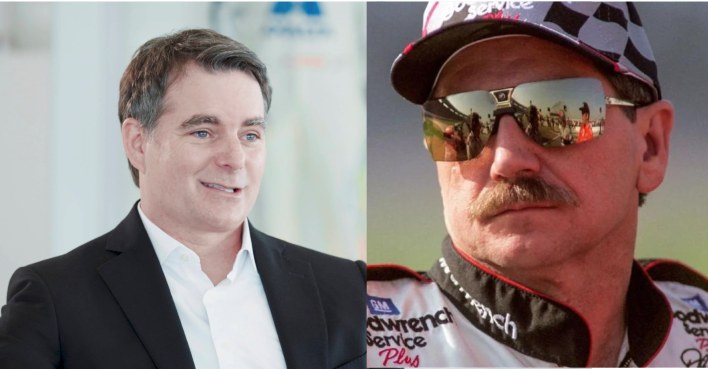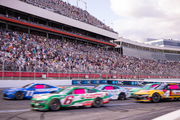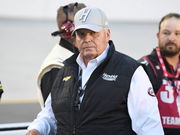
Imago
Jeff Gordon (L) & Dale Earnhardt Sr (R) | Image Credits: Imago

Imago
Jeff Gordon (L) & Dale Earnhardt Sr (R) | Image Credits: Imago
Pressure, uncertainty, and a lot at stake—that’s what Jeff Gordon carried into the 1997 Daytona 500. On paper, Hendrick Motorsports had it all that year: two championship-winning drivers—Jeff Gordon in 1995 and Terry Labonte in 1996—a rising star in Ricky Craven, and the resources to dominate NASCAR’s premier series. But the team’s leader, Rick Hendrick, was battling a rare and aggressive form of leukemia.
Watch What’s Trending Now!
Hendrick’s absence loomed over the team. Diagnosed in late 1996, his illness forced him to stay home as his drivers and crews descended on Daytona for the season’s biggest race. They carried his fight with them, not just in spirit but in action. Gordon’s car featured a sticker on the dashboard displaying 1-800-MARROW-2, a hotline for bone marrow donation. Every driver and crew member knew what winning would mean—not just for their careers but for their boss.
Gordon, being the premier driver and the 1995 Cup Series champion, was the focus heading into the race. However, Gordon was attempting to do something neither he nor Dale Earnhardt Sr. had done before – win the Daytona 500.
ADVERTISEMENT
Gordon’s fear: Would Daytona deny him like it did Dale Earnhardt?
“It was tough,” Jeff Gordon reflected in an interview with HendrickMotorsports.com. “He was always at the track. Especially for the DAYTONA 500, and you knew how much that race meant, even though he’d won it before. We wanted to win it for him.”
The stakes couldn’t have been higher. For Gordon, the 25-year-old phenom with 17 wins in the previous two seasons, the pressure was enormous. He’d won just about everywhere—but this was the Daytona 500. NASCAR’s crown jewel. A race Dale Earnhardt Sr. had spent nearly 20 years trying to win, only to fall short again and again despite his dominance.
ADVERTISEMENT
The haunting legacy of Earnhardt’s near-misses weighed heavily on Gordon’s mind as he rolled into Daytona.
“First of all, it’s the DAYTONA 500, so just that in itself is such a big deal, and I’d never won it,” Gordon said. “From the first time we went, we ran good. Then you take that and how hard that race is to win, knowing Earnhardt and what he’d gone through for years… You don’t know. I’d watched him do everything right, dominate, and not get it done. So you just don’t know.”
ADVERTISEMENT
Gordon’s fears almost materialized during the race. Just past the halfway mark, he suspected a right-rear tire issue and made an unscheduled pit stop. The stop put him a lap down, but a timely caution for Greg Sacks’ crash allowed him to regain his position. As the chaos unfolded around him—wrecks taking out contenders like Dale Jarrett, Ernie Irvan, and Earnhardt himself—Gordon found himself in a prime position late in the race.
With 12 laps to go, a multi-car wreck triggered by Earnhardt’s loose car allowed Gordon and his Hendrick teammates, Labonte and Craven, to line up behind race leader Bill Elliott. It was the break they needed.
“Poor Bill Elliott is the leader, and he has three Hendrick cars behind him,” said Ray Evernham, Jeff Gordon’s crew chief. “He never had a chance.”
ADVERTISEMENT
With six laps remaining, Gordon made his move. A big run allowed him to dive under Elliott, taking the lead as Labonte and Craven followed suit. The Hendrick trio crossed the finish line in formation—1-2-3. Gordon had won his first Daytona 500, fulfilling a dream and silencing the doubters. Gordon’s prowess in that era was unparalleled, as Ken Willis, columnist for the Daytona Beach News-Journal, put it, “At that point in time with Jeff Gordon, you were no longer surprised by any race he won and when he won the DAYTONA 500 that year, you went, ‘Of course. He’s going to win every race where he cranks the engine,’”
“It was special for so many reasons,” Gordon said. “I was overwhelmed with winning the DAYTONA 500. The whole team was. Then I’m talking to Rick on the phone in victory lane, and he’s emotional and excited, and I was too. We’d accomplished what we had set out to do. We’d lit up all the lines on 1-800-MARROW-2, so we were making a difference in the world there. It was a pretty amazing day.”
Top Stories
New Charter Deal Triggers ‘Financial Frenzy’ as NASCAR Teams Set for Massive Payday

Rick Hendrick Strikes Fear in NASCAR Fans With Chevy’s New “Illegal” Car

Major Blow to Trackhouse Racing as Team Penske Steals Veteran Crew Chief Back in Unexpected Move

Chevy Team to Enter Kyle Larson’s Series as Michael Jordan Ends NASCAR’s Monopoly

Martin Truex Jr’s Former Crew Chief Ends 12-Year Fight In Huge Personal Announcement

ADVERTISEMENT
The ripple effect: A victory that defined an era
Winning the Daytona 500 in 1997 wasn’t just a career milestone for Jeff Gordon—it was a turning point for Hendrick Motorsports.
“That race meant everything to us,” Gordon said. “It was the culmination of a lot of hard work and the start of something even bigger.”
The victory solidified Gordon’s place as a NASCAR superstar. Over the 1997 and 1998 seasons, he added back-to-back Cup Series titles and won an astounding 23 races. Hendrick Motorsports, meanwhile, began its ascent to becoming the sport’s premier organization. From 1995 to 1998, they won four consecutive titles, with Jeff Gordon claiming three and Terry Labonte winning it in 1996.
ADVERTISEMENT
Ken Willis described the significance: “They became the Yankees of the Babe Ruth and Lou Gehrig era, the Packers of the Lombardi era, the Celtics of the Red Auerbach era. They were becoming the gold standard of NASCAR.”
The victory also had an immediate and profound impact off the track. The exposure of the 1-800-MARROW-2 hotline during the race led to an estimated 200,000 calls. Decades later, it remains a cornerstone of Hendrick Motorsports’ legacy, supporting bone marrow donation and cancer awareness.
For Gordon and the Hendrick team, that day in Daytona was more than a win, it was a testament to resilience, teamwork, and determination in the face of uncertainty. “It wasn’t just a win for us,” Gordon said. “It was a win for Rick. It was a win for everyone who believed in us.”
ADVERTISEMENT
Decades later, the image of Hendrick’s cars crossing the finish line in formation remains one of the most iconic moments in NASCAR history—a victory that marked the beginning of an extraordinary era.
ADVERTISEMENT
ADVERTISEMENT
ADVERTISEMENT

